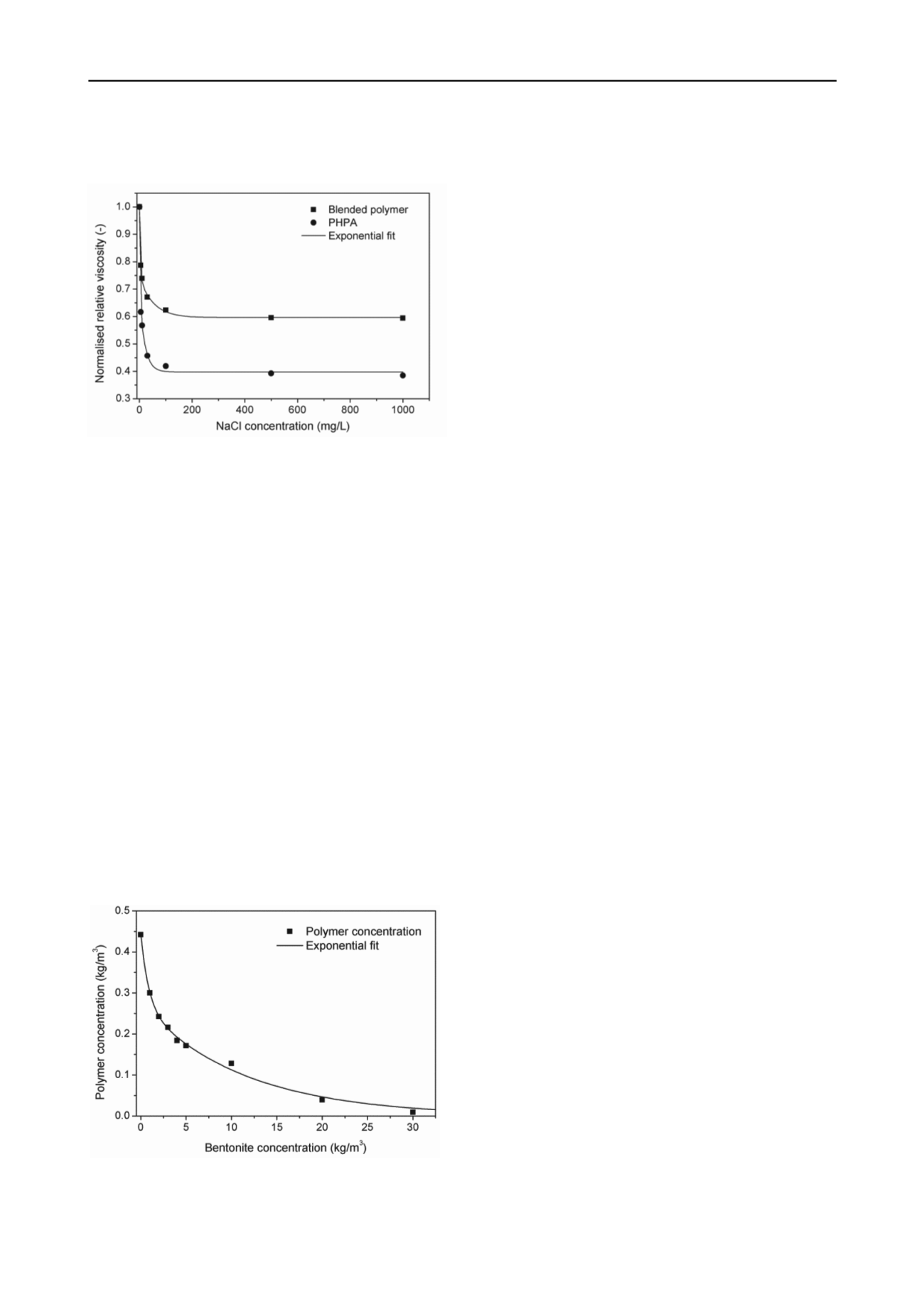
3222
Proceedings of the 18
th
International Conference on Soil Mechanics and Geotechnical Engineering, Paris 2013
systems are available which are more tolerant of ionic species in
soils and these should be used in saline grounds.
4 CONCLUSIONS
Through the use of case histories and recent research findings,
this paper has outlined some strengths and limitations of
polymer fluids as potential replacements for bentonite slurries
particularly for small or congested sites. Strengths include
improved foundation performance, simpler site operations and
reduced environmental impact. Limitations include reduction of
fluid properties due to continued shear in recirculation systems,
potential for loss of properties in saline soils and importantly
sorption of polymers onto soils – which also can be a benefit as
it reduces dispersion of fines into the fluid. To minimise the loss
of fluid properties, fresh polymer must be regularly added to the
system otherwise a significant degradation in performance of
the fluid and potentially the foundation element will occur.
5 ACKNOWLEDGEMENTS
Figure 6. Effect of added sodium chloride on the viscosity of a
commercial blended polymer product and a pure PHPA both mixed in
deionised water.
3.4
Loss of active polymer concentration due to repeated use
The properties of polymer fluids depend on physical and
chemical interactions between the polymer molecules in
solution. An excavation polymer is thus an active chemical
system. Whilst in use in an excavation, polymers tend to sorb
onto soil surfaces, especially those of clays and this can
beneficially reduce the break-up of lumps of cut soil and the
resulting dispersion of fines into the fluid. However, it does
follow that the concentration of active polymer drops with use
and unless the concentration is regularly re-established the fluid
will become little more than muddy water, a condition which
the authors have dubbed as ‘flipped’. The system has ceased to
be polymer solution with some suspended soil and become a
soil slurry with little polymer remaining in solution.
The work presented in this paper was undertaken as part of a
research project jointly funded by the UK Engineering and
Physical Sciences Research Council (EPSRC), Balfour Beatty
Ground Engineering and KB International LLC. EPSRC grant
reference nos.: EP/C537815/1 (Industrial CASE award) and
EP/H50026X/1 (Knowledge Transfer Secondment). The authors
would like to thank Messrs T. Suckling, V. Troughton,
C. Martin, P. Martin and G. Goodhue for their help and advice
throughout the project.
6 REFERENCES
Anonymous. 2001. Way out of a tight spot.
Ground Engineering
34 (5),
16–17.
Bustamante, M., Gianeselli, L., Boato, R. and Conedera, A. 1998.
Performance of polymer slurries in large diameter bored pile.
Proceedings of the 3rd International Geotechnical Seminar on
Deep Foundations and Auger Piles (BAP III)
, Ghent, Belgium,
A.A. Balkema, 119–127.
Recognition of the effects of sorption is absolutely key to the
management of polymer slurries. With hindsight it is now clear
that a number of past problems with polymers can be traced to a
lack of appreciation of the need to replenish the polymer lost by
sorption and thus a wholly insufficient use of polymer.
Caputo, A. 2009. Instrumented large diameter bored piles.
Proceedings
of the 5th International Symposium on Deep Foundations on Bored
and Auger Piles (BAP V)
, Ghent, Belgium, CRC Press, 213–227.
KB Technologies Ltd. 2000.
A SlurryPro CDP case history: Vasco da
Gama Bridge, Lisbon, Portugal
. Trade literature.
To illustrate the effect of polymer sorption, Figure 7 shows
the results of a series of tests on a PHPA-bentonite mix with
increasing concentration of bentonite; the latter was used as a
soil as it strongly sorbs PHPAs. It can be seen that as the
bentonite concentration in the fluid increases, the polymer
concentration drops and ultimately approaches zero.
Lam, C., Troughton, V., Jefferis, S. and Suckling, T. 2010a. Effect of
support fluids on pile performance – a field trial in east London.
Ground Engineering
43 (10), 28–31.
Lam, C., Jefferis, S.A. and Goodhue, K.G., Jr. 2010b. Observations on
viscosity reduction of PHPA polymer support fluids.
Proceedings
of Sessions of GeoShanghai 2010 International Conference
,
Shanghai, China, Geotechnical Special Publications No. 205,
American Society of Civil Engineers, 184–191.
Lam, C. 2011.
Properties and applications of polymer support fluids in
geotechnical engineering
. DPhil thesis, University of Oxford, UK.
Lennon, D.J., Ritchie, D., Parry, G.O. and Suckling, T.P. 2006. Piling
projects constructed with vinyl polymer support fluid in Glasgow,
Scotland.
Proceedings of the 10th International Conference on
Piling and Deep Foundations
, Amsterdam, the Netherlands, Deep
Foundations Institute, 499–506.
Schünmann, D. 2004. Fisherman’s friend,
Ground Engineering
37 (12),
17.
Schwarz, J. and Lange, U. 2004. Brückengründung mit 70 m tiefen
flüssigkeitsgestützten gebohrten Pfählen in Benin/Afrika.
Proceedings of the 19th Christian Veder Kolloquium,
Graz,
Austria, 73–89 (in German).
Thasnanipan, N., Aye, Z.Z. and Boonyarak, T. 2003. Behaviour of
polymer-based slurry for deep-seated bored piles in multi-layered
soil of Bangkok.
Proceedings of the 4th International Geotechnical
Seminar on Deep Foundations on Bored and Auger Piles (BAP IV)
,
Ghent, Belgium, Millpress, 267–274.
Figure 7. Reduction of polymer concentration by sorption.


